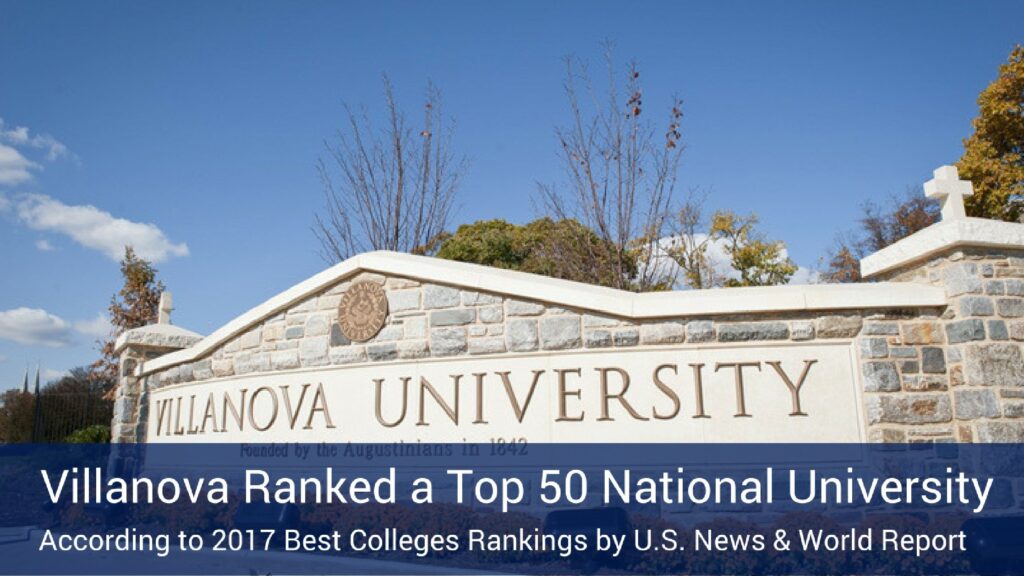
Villanova University Ranked as a Top 50 National University by U.S. News & World Report
Villanova University Ranked as a Top 50 National University by U.S. News & World Report

Last Updated February 3, 2017
For 23 consecutive years, Villanova University was ranked as the number one Regional University in the North by U.S. News & World Report. Then in September 2016, U.S. News ranked Villanova number 50 in the Best National Universities category of that publication’s 2017 Best Colleges rankings. Of the approximately 1,400 four-year colleges and universities ranked in the 2017 U.S. News report, 310 are categorized as National Universities. Its top 50 ranking puts Villanova in the top 16% of nationally ranked institutions on the list.
“This new ranking is a significant milestone in the University’s history, and is one more example of how Villanova continues to move forward academically,” said Rev. Peter M. Donohue, OSA, PhD, Villanova University President in a press release. “It signals the overall strength of the Villanova academic experience and the emphasis we place on successful student outcomes. It will also help Villanova to continue to attract the most talented undergraduate and graduate students, faculty and staff to our University.”
In early 2016, the Carnegie Foundation for the Advancement of Teaching announced that Villanova University had advanced from the Master’s Colleges and Universities category to the Doctoral Universities category. The Carnegie Classification achievement meant that Villanova would no longer appear on U.S. News’ list of regionally ranked universities. Instead, Villanova would be listed among the best colleges and universities nationally.
What is the Carnegie Classification?
Since 1970, The Carnegie Classification has been the leading framework for the recognition and categorization of institutions in the United States that are focused on higher education. Each category is based on the nature and number of doctoral degrees awarded each year and the amount of research activity and grants, along with other measures of scholarly productivity. The classification has been updated every five years since 2000. The changes announced in 2016 were based on performance numbers from 2013-2014.
In 2014, Villanova awarded 20 PhDs spread across three disciplines – engineering, nursing and philosophy. University faculty and students were also involved in a number of research projects funded by federal agencies including the U.S. Department of Defense, the National Science Foundation and the U.S. Environmental Protection Agency.
The Doctoral Universities category is broken into three subcategories: Highest Research Activity, Higher Research Activity and Moderate Research Activity. The placement of institutions into these subcategories is primarily based on the funding and staffing of research activities and the distribution of doctoral degree conferrals across a number of different fields. Villanova is classified as a Doctoral University, Moderate Research Activity.
“With our new classification, we have the opportunity to create a new model as a doctorate-granting institution that produces a select number of PhD degrees, has research in niche areas and offers a wide variety of master’s degrees, while still being focused on – and devoted to – the undergraduate experience,” said Rev. Donohue. “Doctoral education and high levels of research are critical to Villanova’s future as a thriving academic institution and serves to enhance our mission.”
Methodology Behind the Rankings
Since U.S. News & World Report’s first college rankings list was announced in 1983, the Carnegie Classification has been the basis for the array of categories established by U.S. News. Each university is placed into one of four categories depending on its Carnegie Classification. The purpose behind the categories is to allow people to compare schools with similar missions.
Villanova now appears among other nationally ranked universities, each of which share the same dedication and commitment to higher education and the output of innovative research. The other three categories are National Liberal Arts Colleges, Regional Universities and Regional Colleges. It is uncommon for institutions in the Regional University category to offer even a small number of doctoral programs, which is why Villanova is no longer part of this category.
According to U.S. News, “schools in the National Universities category offer a full range of undergraduate majors, plus master’s and doctoral programs. These colleges also are committed to producing groundbreaking research.”
Once the schools are separated into categories, U.S. News gathers data from each college based on 15 of what they call, “indicators of academic excellence.” They assign each factor a weight reflecting their judgment about how much each particular measure matters. Then, the universities in each category are ranked based on their composite weighted score.
What a National Ranking Means for Villanova
Villanova’s shift from regional to national ranking not only reflects the growth of the university over the past few years, but also demonstrates the undeniable strength of its academic programs.
According to Villanova’s Provost, Patrick G. Maggitti, PhD, this strategic move by the school was intentional and has been in the works for some time.
“These changes allow Villanova to create a new model as an institution with an unwavering focus and commitment to undergraduate education that also graduates a select number of PhDs, produces world-class and relevant research in a variety of areas, and offers a wide range of master’s degrees,” he said.
“Villanova is an excellent example in higher education of how undergraduate and graduate education can strengthen the overall academic experience and provide a return on investment that is unrivaled,” Maggitti added.




